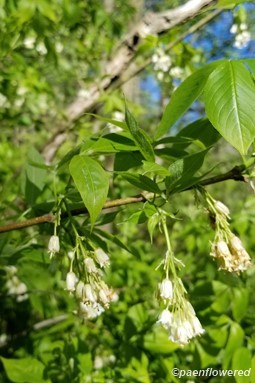Staphylea trifolia
A native shrub with white bell-like flowers
Staphylea trifolia bladdernut
This species of the bladdernut family grows in the form of a large deciduous shrub or small tree. It can be 8-15 feet tall. It grows drooping clusters of 1/3-inch long bell-shaped flowers that are cream in color. The flowers have 5 outer sepals and 5 inner petals. Inside are several stamens and a single pistil. As the flower matures the outer sepals become light green or dull pink.
The fruit, which matures in late summer, is a papery bladder with 3 chambers and changes from green to yellow to brown as it matures. It can persist into early winter. The fruit contains several large black seeds. By late fall these seeds rattle around inside the fruit. The seeds can be eaten like pistachios and can be used in place of walnuts to cookies. A sweet, edible oil can be obtained from the seeds.
The opposite leaves are dark green and divided into 3 lobes with a toothed margin. Each leaf is about 2 .5 inches long and 1 inch wide. The bark has fine white cracks. The twigs tend to be smooth and reddish-brown.
The species is tolerant of drought and shade and can grow in dry rocky soil or in clay. It is common in bottomlands, along stream banks and in woodland thickets. It is a fast growing tree that can spread to form colonies by suckering. It can be found throughout the eastern half of the North America except for the state of Maine. Populations in the deep south are scattered and it not found in the Florida Peninsula. It can be found in several counties of Western Pennsylvania, though range maps differ. It is most abundant in the Mid-western states of Ohio, Indiana, Illinois and Missouri.
Habitat & Range
Grows in rocky, moist woods and along streams.
Present throughout the state.
| EMP: | FAC |
|---|---|
| NCNE: | FAC |
Phenology
Flower from April to May.
Plant Codes
S-rank: S5 (Secure)
G-rank: G5 (Secure)







Comments
Have you spotted this plant in your area? We'd love to hear about your experience! Share your comments or questions about the plant below. Comments are moderated before posting.